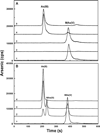Demethylation of methylarsonic acid by a microbial community
- PMID: 21272184
- PMCID: PMC3763196
- DOI: 10.1111/j.1462-2920.2010.02420.x
Demethylation of methylarsonic acid by a microbial community
Abstract
Arsenic is one of the most widespread environmental carcinogens and has created devastating human health problems worldwide, yet little is known about mechanisms of biotransformation in contaminated regions. Methylarsonic acid [MAs(V)], extensively utilized as an herbicide, is largely demethylated to more toxic inorganic arsenite, which causes environmental problems. To understand the process of demethylation of methylarsenicals, soil samples commonly used on Florida golf courses were studied. Several soil extracts were found to demethylate MAs(V) to inorganic arsenite [As(III)]. From these extracts, a bacterial isolate was capable of reducing MAs(V) to MAs(III) but not of demethylating to As(III). A second bacterial isolate was capable of demethylating MAs(III) to As(III) but not of reducing MAs(V). A mixed culture could carry out the complete process of reduction and demethylation, demonstrating that demethylation of MAs(V) to As(III) is a two-step process. Analysis of the 16S ribosomal DNA sequences of the two organisms identified the MAs(V)-reducing and the MAs(III)-demethylating isolates as belong to Burkholderia and Streptomyces species respectively. This is the first report of a novel pathway of degradation of a methylarsenical herbicide by sequential reduction and demethylation in a microbial soil community, which we propose plays a significant role in the arsenic biogeocycle.
© 2011 Society for Applied Microbiology and Blackwell Publishing Ltd.
Figures








References
-
- Akkari KH, Frans RE, Lavy TL. Factors affecting degradation of MSMA in soil. Weed Sci. 1986;34:781–788.
-
- Bachmann BJ. In: Derivations and genotypes of some mutant derivatives of Escherichia coli K12. In Escherichia coli and Salmonella typhimurium: Cellular and Molecular Biology. Neidhardt FC, Ingraham JL, Low KB, Magasanik B, Schaechter M, Umbarger HE, editors. Washington, DC, USA: American Society for Microbiology; 1987. pp. 1190–1219.
-
- Bhattacharjee H, Rosen BP. Arsenic metabolism in prokaryotic and eukaryotic microbes. In: Nies DHS, Simon S, editors. Molecular Microbiology of Heavy Metals. Heidelberg, Germany: Springer-Verlag; 2007. pp. 371–406.
Publication types
MeSH terms
Substances
Grants and funding
LinkOut - more resources
Full Text Sources
Other Literature Sources
Molecular Biology Databases
Research Materials

